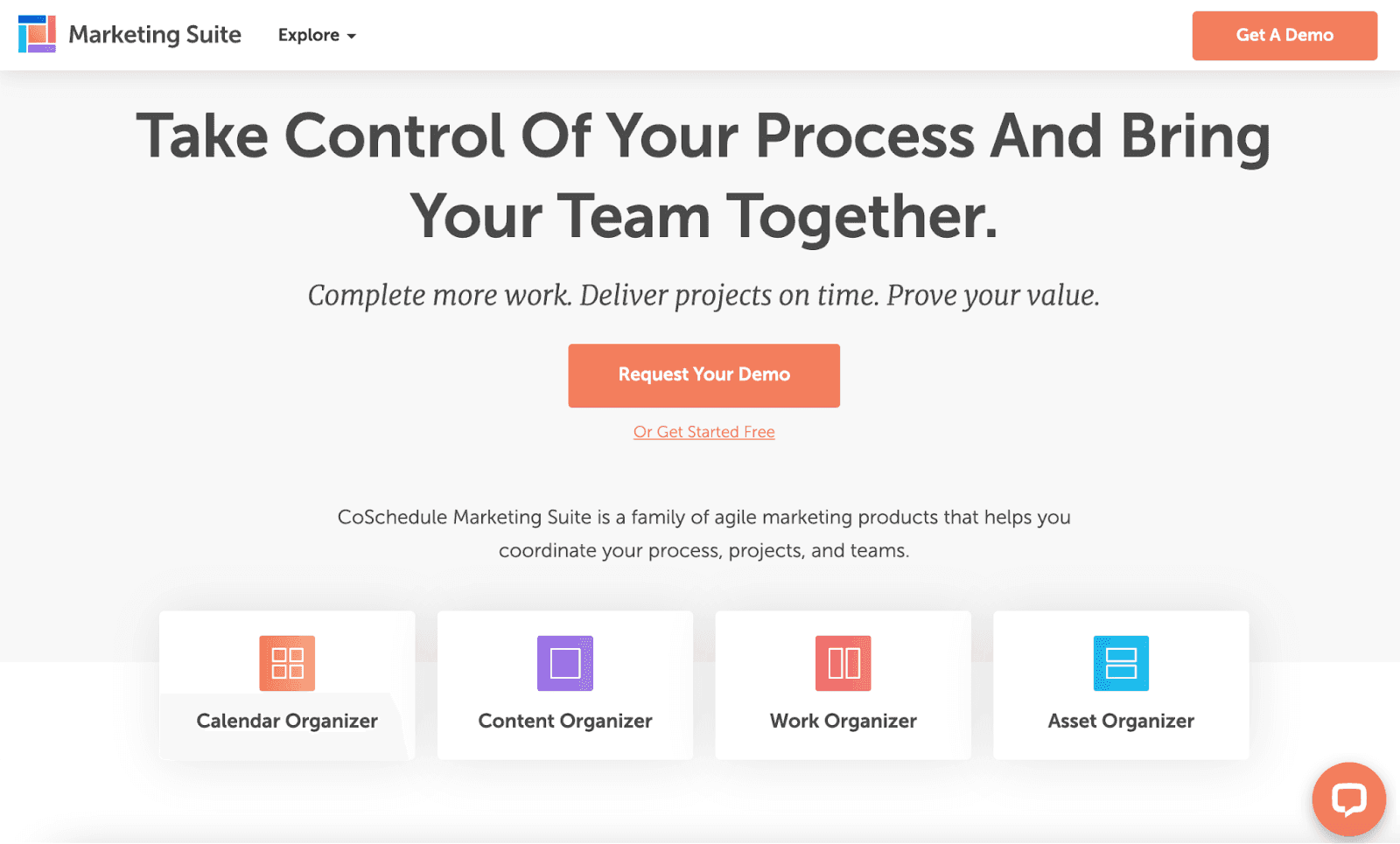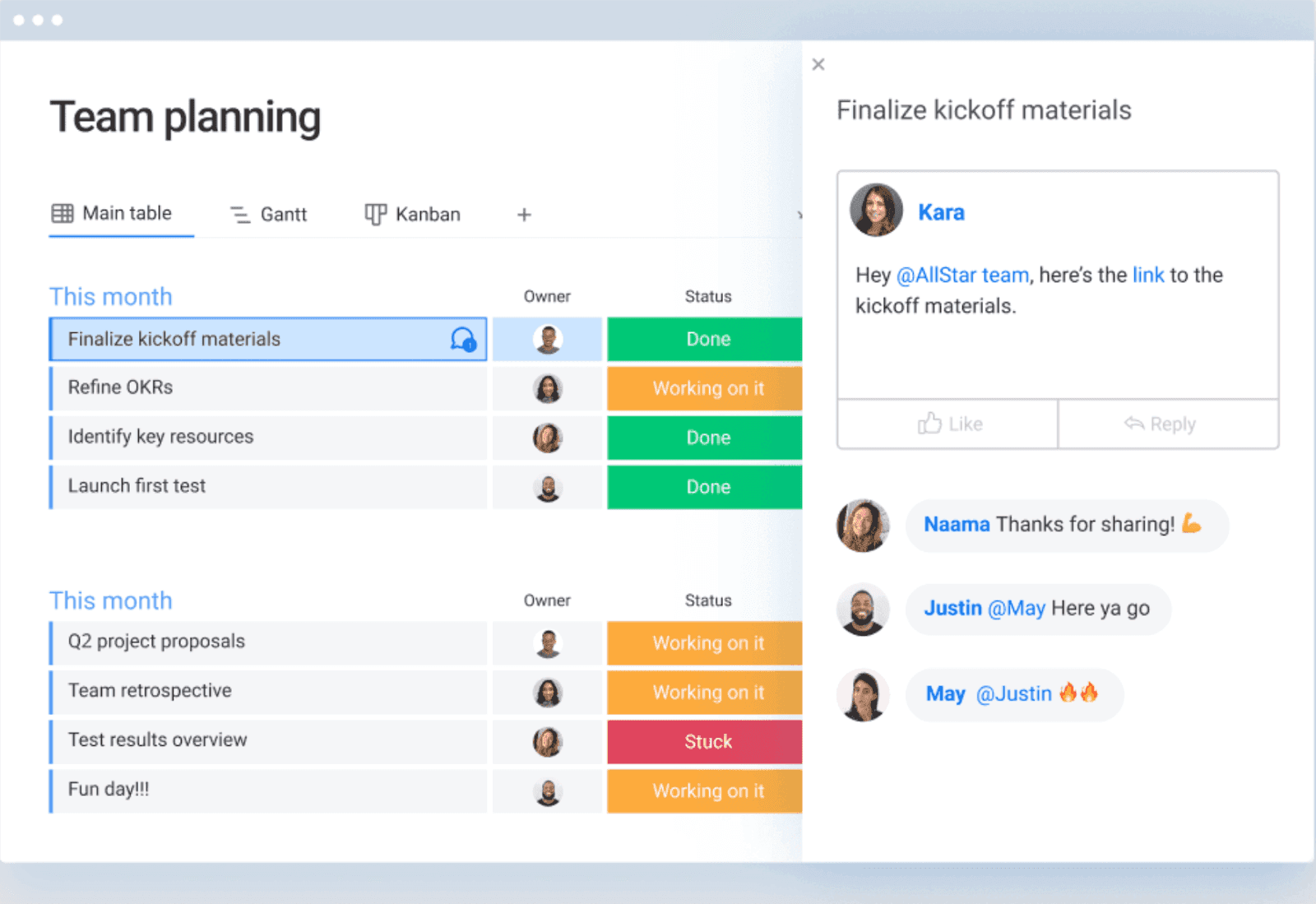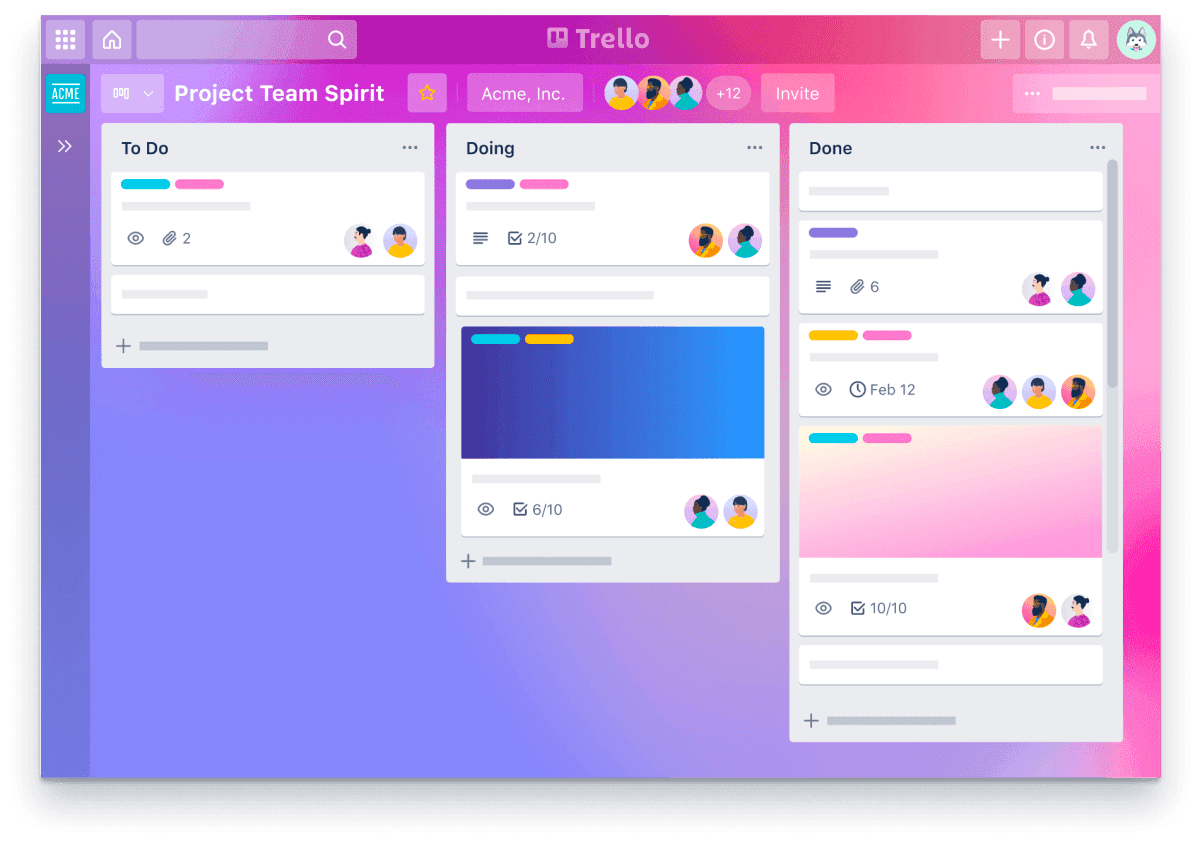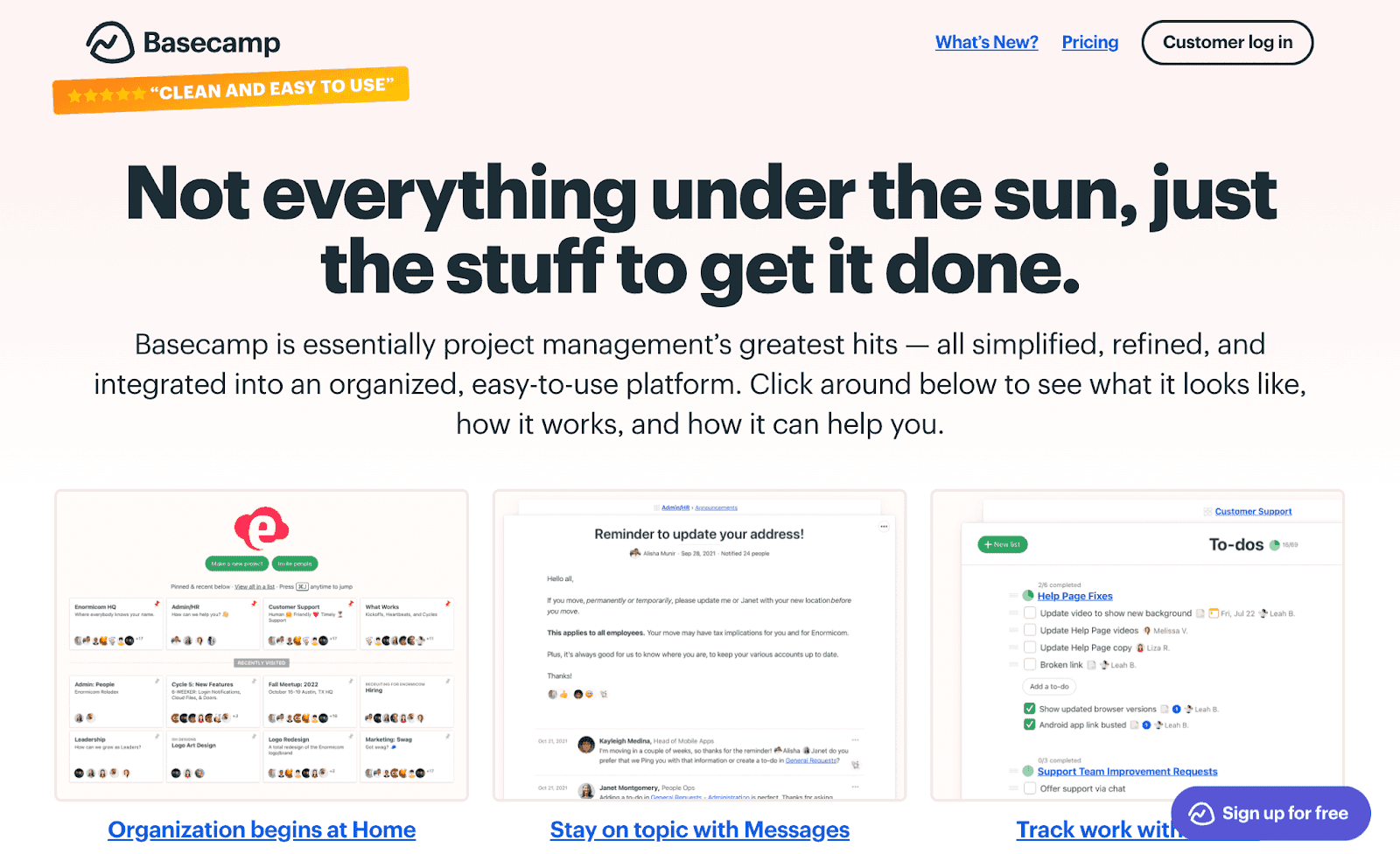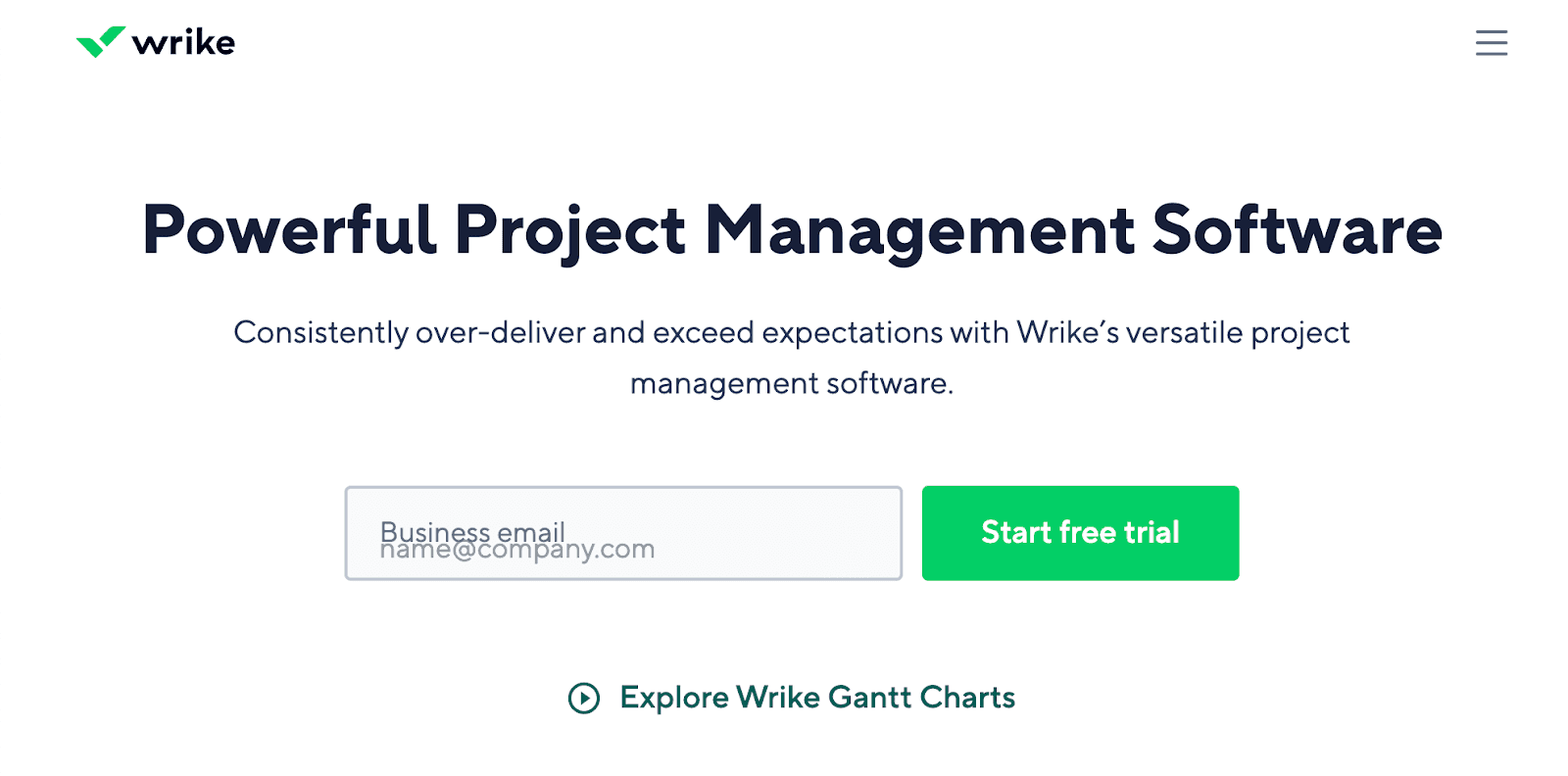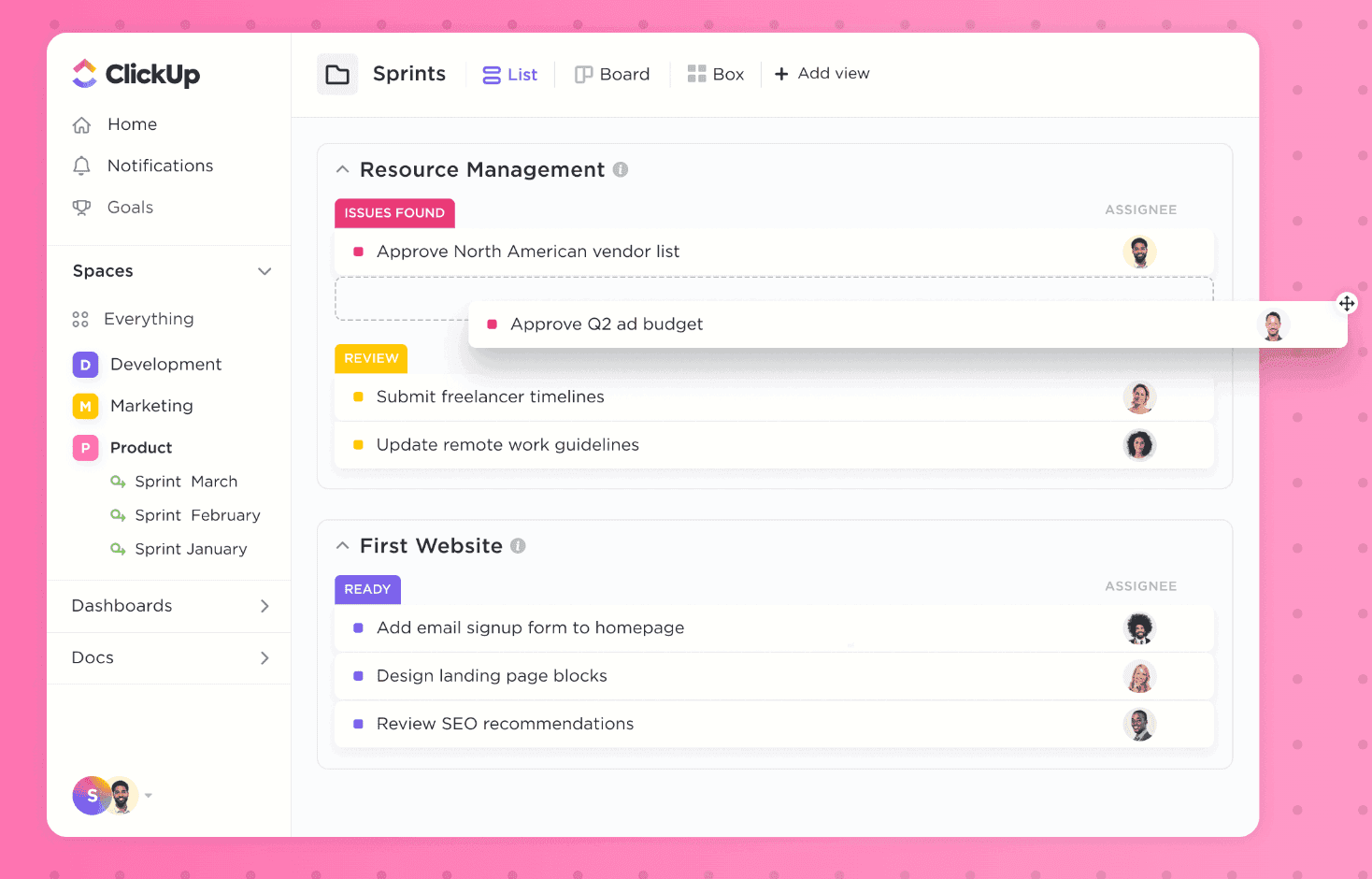Organized marketers are 674% more successful than disorganized marketers.
Marketing project management organizes initiation, planning, execution, monitoring and control, and closure to set clear expectations, hold individuals accountable, achieve deadlines, and influence results.
Solid marketing project management can influence a happy, productive team that collaborates well, enjoys each others’ company, creates amazing work, and generates massive wins. I know this from personal experience here at CoSchedule; and in this piece, you’ll learn the classic phases of project management as I apply them to managing marketing projects.
Let’s explore marketing project management!
What Are Marketing Projects?
The definition of marketing projects:
Marketing projects are single pieces of work and deliverables that most effectively complement marketing campaigns and programs.
Marketers often use marketing campaigns and marketing projects interchangeably as synonyms. At CoSchedule, we define a marketing project as a single piece of content, such as a web page, designed to effectively complement marketing campaigns and programs.
This makes sense to us because in the marketing industry, we have a term that defines a group of marketing projects that are unified around a common message or goal—marketing campaigns. For example, a marketing campaign would be publishing a website with many webpages.
That said, project management as a term is much broader and envelops multiple phases of progression including initiation, planning, execution, monitoring and control, and closure. As marketers, we may apply these phases of project progression to a single piece of work or a group of projects as a marketing campaign. You’ll learn all about these phases of project management as applied to the specific purpose for marketing throughout this piece you’re currently reading.
Types Of Marketing Projects & Examples
An example of a marketing project is a web page. The web page could be part of a campaign that communicates a unified message for a product launch. Additional projects within that campaign could be an email, a social media message, and a press release.
Marketing Project Examples:
- Web page
- Social media message
- Blog post
- Advertisement
Marketing Campaign Examples:
- Product launch: A product launch campaign may include multiple marketing projects such as web pages, emails, social media campaigns, videos, news releases, blog posts, and advertisements.
- Branding initiative: A branding campaign such as a merger or acquisition would undoubtedly involve many marketing projects including complete website revitalizations, email campaigns, news releases, and advertisements.
- Seasonal sale: A seasonal sale such as a Black Friday sale may include multiple marketing projects such as emails, landing pages, advertisements, and social media campaigns.
What Is Marketing Project Management?
The definition of marketing project management:
Marketing project management is the initiation, planning, execution, monitoring and control, and closure of marketing deliverables, campaigns, and programs.


Let’s break down the definition of marketing project management.
The 5 phases of marketing project management:
- Initiation: What is the scope of what you’ll create?
- Planning: How will you create your content and with what resources?
- Execution: Create your content.
- Monitoring and control: Identify and remove any roadblocks that are preventing you from executing.
- Closure: Get approval, publish, and review.
Project management principles may apply to:
- Marketing deliverables: Assets marketers create, often as pieces of content.
- Marketing campaigns: A group of marketing projects that communicate a common message with a shared goal.
- Marketing programs: The ongoing initiatives, activities, and methodologies that strategize and standardize specific marketing tactics, channels, and content.
Why Is Marketing Project Management Important?
Aligning Marketing Project Execution With Strategic Business Objectives
The mark of bad project management is a “lack of insight, foresight, and knowledge of what it entails to drive your team to produce excellent results,” according to Thomas Mirmotahari of PerkUp. “Smart project planning includes a thorough understanding of the goals of the project against a system of execution that supports meeting those deadlines and targets at measurable intervals.”
Avoiding Wasted Marketing Efforts & Costly Mistakes
David Rowland, Head of Digital Marketing at EcoOnline, notes, “A well-thought-out strategy can help you avoid many potential mistakes. Planning well ahead of time can allow you to avoid wasted time or effort. It can also allow you to build a solid framework for your project, which makes it easier to stay on track and move forward with your work.”
Setting Realistic Marketing Schedules & Roadmaps To Keep Teams Happy
Jonas van de Poel, Head of Content Marketing at Unmuted, pegged mapping out a reasonable project schedule as the most overlooked project management skill: “Project Marketing is a creative, complex process. When you kill this process with deadlines that are unnecessarily tight, this will eventually show in your results. […] Any smart marketing project manager will add buffers to allow room for those magical final touch edits. It’s this room to breathe that separates successful and unsuccessful marketing project management.”
Meeting Marketing Goals With A Reliable System
Chaenara O’Brien, Head of Strategy at Thought Bakery, has this advice for you: “If you’re not using a project management tool to optimize your marketing activities at the moment, you should evaluate whether your future marketing goals can handle the risk of things falling into chaos without a reliable system.”
Speaking of the importance of knowing how to use tools like CoSchedule efficiently, Chaenara continued: “They are priceless as they help bridge the gap between a long list of tasks and the pipeline of effort you still have available within your resource allocation.”
Research backs this up: 83% of successful marketing teams use collaboration tools (compared to just half of the least successful.)
Additional Benefits Of Marketing Project Management
Strategic marketing project management will help you:
- Work even faster and collaborate better than ever by managing your projects with an efficient process from the get-go.
- Focus 100% of your resources on the right projects instead of “we’ve always done it that way” tasks that don’t add measurable growth to your bottom line.
- Boost your productivity while getting organized and taking control of your entire process.
There are five phases of marketing project management. The following steps are how I’ve personally managed the marketing team at CoSchedule for nearly a decade, which work well for our smaller team.
Initiate
Step 1: Choose The Highest Priority Project From Your Marketing Project Backlog
Part of the agile project management process involves creating and maintaining a product backlog. For your purposes, that’s a fancy definition for a prioritized list of marketing projects.
Project management starts by strategically choosing to complete the highest priority project on your list. Since that’s the case, we wrote an entire post to help you create your own marketing project backlog:
Related Reading:
Step 2: Clarify Project Requirements & Specifications With A Creative Brief
Creative briefs pull pertinent project info—like who needs to do what and when—into one place. It is a simple outline of everything the project will entail, including:
- Project description
- Deliverables
- Project goals
- Team members and points of contact
- Project workflow and timeline
Some questions to consider:
- Who will this project benefit the most? Pinpoint a subset within your audience.
- What do you need to create? Define the end deliverable.
- Why will this project benefit the audience you’ve specified? Write your value proposition that answers your audience’s question, “What’s in it for me?”
- What kind of resources might you need to complete the project? Estimate the time, tools, and budget involved.
- What does done look like? Help your team know what you’ll accept as a successful final project—defining the scope.
- Who needs to be involved? Define all stakeholders including awareness, opinion, approval contributors as well as creators.
- When will you execute the project? Estimate or define your timelines and milestones.
- How will you communicate, monitor, and control project progress? Define the ceremonies, meetings, and tools you’ll use to keep the project on track.
- How will you measure success? Define your KPIs and attribution methodologies.
As you write your creative brief to answer these questions, you’ll immediately be able to spot areas of potential challenges that you can work to resolve now—before your team starts executing the project.
Plan
Step 3: Map Out The Project Task Roadmap
Tasks are important because they break down a large project—which may seem difficult to even know where to start—into manageable phases with clear accountability expectations.
- Identify dependencies for each task. What work must be done first so that other tasks can be completed successfully? Figuring this out can prevent delays from skipped steps, having to redo work that was done without the necessary inputs or from team members being forced to wait for resources.
- Put tasks into chronological order. With all tasks outlined and turnaround times set first, it’s much easier to avoid skipping steps or assigning tasks in the wrong order.
For example, to publish a landing page project, you may list the tasks you need to complete in chronological order:
- Research landing page designs that convert
- Outline the landing page based on the research
- Write the landing page text
- Wireframe the landing page
- Design the landing page
- Develop the landing page
- Review the landing page
- Set up landing page measurement with an analytics tool
- Publish the landing page
- Measure the landing page
- Report landing page results
- Retro on the landing page project
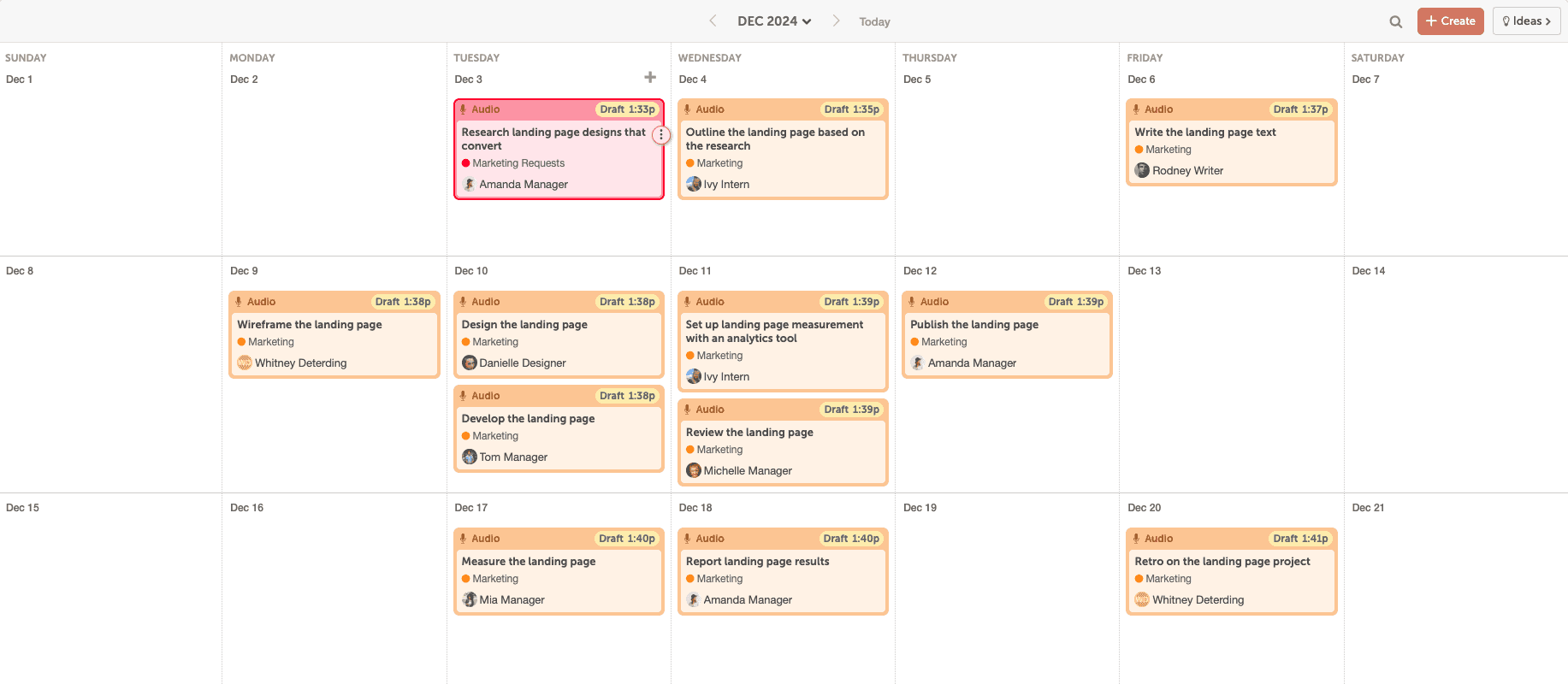
You get the idea—the point is to break down a project into a step-by-step process.
Step 4: Estimate The Level Of Effort To Define Milestones & Deadlines
It’s one thing to give your team a deadline to complete a project and another to know that the deadline is realistically achievable.
To set realistic deadlines, you will need to define:
- Who will be accountable for completing each task. These are the team members who’ll work together to complete the stories.
- The level of effort for each task. In other words, how much time will it take the person you’ll assign the task to complete it?
For each task, write down who on your team you think is best suited to complete it the fastest. Then visit with each team member to ask how much time they’d estimate for every one of their tasks.
Since you estimated the level of effort for each task—and understand how much time each individual needs to contribute—you can realistically plan your project sprints and subsequently know your deadline when the project will be 100% complete.
Step 5: Proactively Review & Approve The Project Plan With Stakeholders
Make sure you publish on time by preventing project thrashing—otherwise known as scope creep and last-minute changes—before you begin executing.
Seth Godin has the best advice I’ve ever seen on this topic. Read Linch Pin to get the full scoop—and for your marketing project management, start here:
- Set the date when you’ll publish. This is when you’ll launch your project no matter what.
- Involve others in your initiation and planning process and write everyone’s ideas down. This is important for your big stakeholders because, as Seth says, “This is their big chance.”
- Show what you plan to do. Give them the opportunity to thrash your plan before you start executing. Changes now are alright, but once your team starts executing, this thrashing will dramatically impact your deadline.
- Give them an opportunity for one final review. Seth says, “Make sure everyone understands that this is the very last chance they have to make the project better.”
- Revise the project blueprint into a final, comprehensive outline.
- Show your plan to the stakeholders and ask, “If I deliver what you approved, on budget and on time, will you ship it?”
- Only start executing once you get your yes. No maybes. Then deliver what you promised, thrash-free.
This simple process should prevent scope creep, last-minute modifications, and other nitpicking with small details because you’ve nailed the big picture.
Execute
Step 6: Assign Project Work To Individual Contributors
It’s finally time for your team to start creating content for your project! You just need to delegate them the tasks to complete.
The best way to manage a marketing project is with software that helps you:
- Manage your entire team and easily assign each individual their specific tasks to complete (without workarounds).
- Assign specific deadlines for tasks to be completed on specific calendar dates.
- Automatically notify individuals that you’ve assigned them a task to complete.
- Automatically remind your team as a due date for a task approaches.
- See which tasks are completed, which should be in progress, and which are coming up.
- Understand which tasks are overdue that may cause you to miss your deadlines.
- See individual team member capacity to take on more work or to move tasks around as needed.
CoSchedule offers two content calendar products designed to be marketing management software.
Both Marketing Calendar and Marketing Suite by CoSchedule meet all qualification requirements for best-in-class marketing project management software. This software is recognized on Gartner’s Magic Quadrant for Content Marketing Platforms as a strong agile marketing management platform.
Step 7: Communicate & Collaborate With Marketing Project Management Software
While emails serve nicely as notifications and reminders to help your team get into the system where you manage your projects, they’re not so great for managing project communication.
That’s where it’s nice to manage your team communication around the project in the project management tool where you manage everything else. There are a few qualifications to make this work for your project:
- Avoid email to manage your project communication. Email forwards and strings can miss some replies to sender only, which can cause team members to miss critical information on your projects.
- Agree as a team to communicate consistently with the same tools for your specific purpose. This will help you maintain one version of the truth for all project communication to help the team collaborate more efficiently.
- Keep your comments, notes, and progress reports in the same tool where you manage your task board or workflow. This is especially important if you manage multiple projects at once.
Marketing Calendar and Marketing Suite by CoSchedule empower this kind of communication and collaboration to help you execute your project smoothly.

Monitor & Control
Step 8: Schedule Meetings To Track Project Progress
Tracking how well your plan is going is crucial for the successful management of marketing projects. (That’s especially true if your team works remotely.)
How you should go about it depends on your company and team.
If your company uses agile marketing, then daily standups may be sufficient to track advancement toward key milestones. Otherwise, it may make sense to schedule more structured recurring meetings—for example, weekly meetings—to get status updates from various teams.
No matter what type of meetings you settle on, though, the important thing is that you make the most of them. (Let’s face it: most meetings could have been an email.)
Create an agenda, and instead of focusing solely on progress to date, use meetings to anticipate and prepare for potential roadblocks. If you do, it’ll be easier to give team members what they need to finish their work successfully and on time.
A standard work-in-progress meeting agenda often includes:
- What did you do since our last meeting?
- What will you do before our next meeting?
- What prevented you—or will prevent you—from completing your work?
Close Out
Step 9: At the End, Review What You Learned
Once the project is done, don’t anxiously move on to the next.
Take time to reflect—both as a team and as the marketing project manager—on these questions:
- What went well? And don’t just think about the KPIs you tracked; also consider unexpected wins and the factors that contributed to them. Write down what went well as far as team collaboration, communication with stakeholders, the project workflow, and so on.
- What didn’t go so well? Think about the objectives you didn’t meet, areas in which your teamwork could’ve been better, and where you fell short as a PM.
- What could be improved in the future? Reflecting on past projects isn’t of much use if you don’t put the lessons you learn into practice. So, turn your observations into practical steps that’ll get better results on future projects.
By having open discussions about these questions and doing an honest evaluation of your performance as a project manager, you can exponentially increase your (and your team’s!) success on future campaigns.
Many project management tools are designed to manage projects for every industry. For this reason, most project management tools are not the best fits for marketing use cases.
Imagine a software that manages construction projects, human resources projects, and marketing projects. Tools like these manage tasks but often leave more to be desired for marketers—such as content calendar views, kanban views, team capacity and handoff views, and stakeholder read-only views.
Only software truly designed for marketing use cases provides the best project management experiences for marketing teams. So this list begins with content calendar products by CoSchedule that integrate with the tools marketers use daily and empower them to collaborate most efficiently and effectively.
1. Marketing Suite By CoSchedule
CoSchedule Marketing Suite is a set of agile products for creating processes and managing projects with your team. This tool improves team productivity by reducing email communication through real-time chats, helps you create content workflows from ideation to distribution, and provides team-wide project visibility, which makes everyone accountable for their tasks.
Marketing Suite also helps you organize content deliverables and brand assets in respective folders, which you can securely share with stakeholders using custom sharing links.
2. Marketing Calendar By CoSchedule
CoSchedule Marketing Calendar is a must-have in your project management arsenal. You can use it to store ideas, create and manage projects, assign tasks to team members, set deadlines, create, schedule, and publish social campaigns, and also analyze results with social reports.
Doing all these in one place helps your team prioritize tasks since they have instant clarity into their projects. Plus, they have access to real-time team collaboration features, can share project updates with managers, set up repeating tasks, duplicate existing projects, and do much more. The best part? You can use Marketing Calendar for free.
3. Airtable
Airtable is a cloud-based tool for building a custom project management dashboard. With this tool, you can automate processes, get notified about the status of projects, manage projects with views like kanban, grid, calendar, gallery, and timeline, and seamlessly collaborate with your team. Airtable also has a customizable reporting feature containing charts and graphs to track the progress of your team’s work.
4. Monday
Monday is a powerful tool that allows you to manage multiple projects, monitor performance, and update changes to projects in one place. This tool helps you buy back your time by automating processes like project approvals. It also eliminates siloed conversations since your team can stay updated with information on their assigned tasks and track progress in a centralized location.
5. Asana
Asana is an excellent project management tool that goes beyond assigning projects, tracking progress, and collaborating with team members. This tool allows marketers to collaborate with guests. If you want specific projects to stay private, Asana lets you hide those projects. With Asana, you can set projects to comment-only to prevent any team member from making accidental changes. This tool also has a pro backup feature for recovering data that you permanently deleted.
6. Trello
Trello is an easy-to-use project management tool with multiple viewing options. The views help you get complete visibility on all your marketing projects. Trello’s Butler, a no-code built-in app, recognizes repetitive tasks and suggests automating the process. You can set rules and commands and get them done with Butler. Trello integrates with apps like Slack, Email, and Jira, and it has a free and paid version with a starting price of $5 per month.
7. Basecamp
Basecamp is a simple-to-use tool that allows you to create communication boards, set up to-do lists, attach files to any task, and track work progress. You can link Google docs, have conversations on files, do group chats with team members, schedule events, and set up recurring work on Basecamp. Basecamp also links to cloud software like Figma and Airtable. The app has a free version, and its paid version costs $11 per month.
8. Wrike
Wrike has many functions, but its AI integration makes it unique. Through a voice command, you can tell Wrike what to do, take snapshots of written text, and watch as Wrike turns it into a digital document. You also get notifications of ‘at risk’ projects.
This tool supports 31 app integrations. And with its report analytics software, you can track performance and report to higher-ups. Like other project management tools, Wrike has different views, lets teams collaborate in real-time, monitors due dates, and helps you prioritize work. It has a free version, and the professional plan starts at $9.80 per month.
9. Workfront
Adobe Workfront is an enterprise project management tool that integrates with popular software like Slack, Jira, Salesforce, etc. Besides possessing the nice-to-have of a project management tool, Workfront has issue tracking and resource allocation features. Issue tracking allows team members to log unexpected challenges with projects or tasks. And resource allocation helps you identify your best team members for a project, including their bandwidth.
10. ClickUp
ClickUp is an excellent tool for task management and team collaboration. Its new Whiteboard feature allows you to create a canvas so team members can contribute ideas for your marketing projects. ClickUp also gives you complete project visibility. You can visualize your team’s work capacity and identify those with excess or little work. This helps you shift tasks, so you don’t overburden some team members while others remain bored because of less work.
What Skills Should A Marketing Project Manager Have?
To be successful as the project manager of a marketing project, you need a mix of soft and technical project management skills.
Necessary soft skills include strong:
- Written and oral communication so that everyone’s clear on project details.
- Conflict resolution to quickly resolve disagreements or misunderstandings that could threaten the progress or success of a project.
- Strong leadership to provide structure, keep execution streamlined, and motivate team members to do their best work.
- Time management to keep yourself and everyone else moving forward. (Spoiler alert: High-impact tasks should receive the most attention.)
- Subject matter expertise for a realistic idea of the project scope, a well-rounded understanding of the steps leading to the end goal, and better communication with stakeholders.

“What about technical skills?” I hear you ask.
This isn’t necessarily a complete list, but it covers the major competencies you’d do well to develop. Consider this a short list of what you need to get by (which is really what we’re going for here).
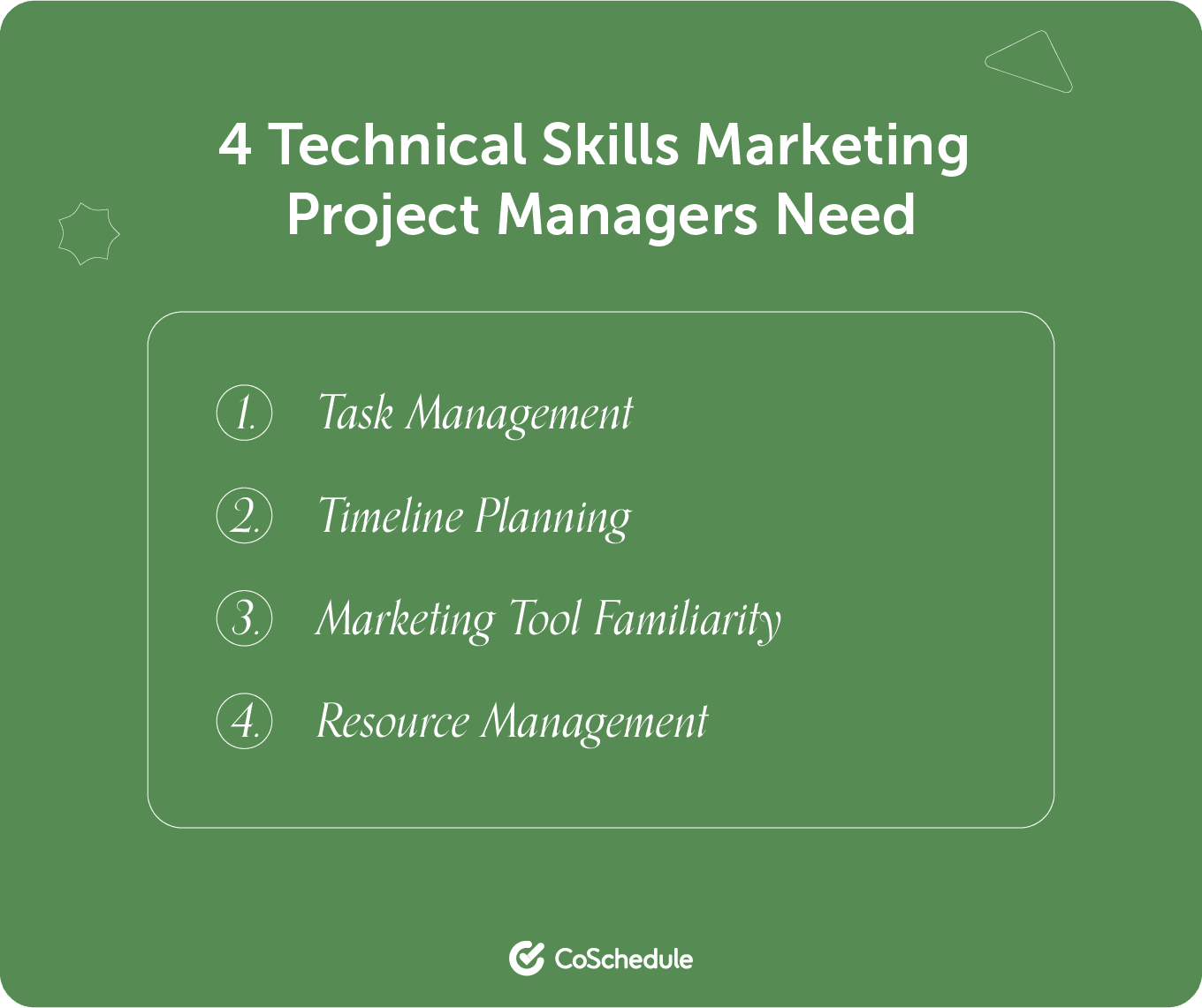
- Task management to develop strategic plans of action to get the desired outcomes.
- Timeline planning includes setting reasonable deadlines that allow for unexpected delays and managing stakeholder expectations. On any given project, you’ll likely have multiple people working on different pieces of the greater whole.
- Familiarity with marketing project management tools like CoSchedule. You’ll have one dashboard to store project info and to-dos. The result? Frictionless teamwork and campaign execution.
- Resource management, including time, money, and people to get the work done according to plan.
What Are A Marketing Project Manager’s Responsibilities?
Beyond planning and assigning tasks, a project manager wears the hat of a leader and should be a few steps ahead of the team. This means you should recognize and fix problems before they become an emergency. To run your marketing projects smoothly, here are some tasks to cater to as a project manager:
Scope
Knowing how to set a project’s limits, expectations and deadlines should be your forte as a project manager. As the marketing project manager, you must draft the project scope, get stakeholders’ approval, ensure your team sticks to the plan during the implementation phase, and achieve all project goals before the deadline.
Prioritization
Prioritization makes project management a breeze. While marketing projects may seem overwhelming initially, the project manager sets things in motion by prioritizing and assigning tasks that provide the greatest value to the target audience and guarantee the project’s success. One way to think about this is using the 10x versus 10% framework. Here’s how it works:
Resources
A marketing project manager allocates and manages the people and technology needed to create, distribute, measure, and maximize marketing activities. Good resource management skills are crucial to ensure funds and team members are used to the best of their abilities.
Timelines
It’s the project manager’s responsibility to delegate tasks, set reasonable deadlines, and follow up with team members with reminders on the delivery date. You can do this with a project management software like CoSchedule, which provides real-time collaboration with your team.
Budget
A project manager must know how to budget for every project accurately. If you underbudget, you’ll put projects at risk and may miss deadlines. If you overbudget, you’ll have to put some projects on the back burner and miss out on potential results.
Communication
The ability to keep communication lines open and up-to-date with the project team and stakeholders is an essential responsibility of a marketing project manager. A hitch in communication can affect a team member’s performance and the project’s progress.
Relationship Management
To manage people, you need to be approachable. This allows your team, stakeholders, and external vendors to contribute freely and give feedback on a project. It also motivates everyone to respect your decisions as a project manager and adhere to your timelines.
Reports & Documentation
During and after a project, it’s good practice for the project manager to document processes, changes, challenges, and performance. This helps stakeholders to do data-backed performance reviews.
Common Marketing Project Management Challenges & Risks
Like daily life, no project follows a linear pattern. Every project will experience challenges that put it at risk of reaching the finish line on schedule. Here are some challenges you may have when doing marketing project management.
Setting Expectations & Accountability
Set expectations may be easy, but getting vendors or team members to deliver may be challenging. For instance, if an article or website redesign doesn’t hit the mark on the first try, some back and forth will be required to get a polished deliverable. This is where the accountability of the vendor or team member takes center stage. If they aren’t invested in the project, they could put your deadlines and the results you expect from the project at risk.
Scope Creep
Scope creep is a significant challenge that can alter the entire structure of a project. This occurs when you don’t get stakeholders’ buy-in before executing a project. The result? Stakeholders may turn down a project deliverable or add more work, causing a strain on the team and an extended timeline. To avoid this, ensure you collaborate with stakeholders at every stage of the project lifecycle.
Insufficient Budget
Funding could be a problem. While some executives may reduce their marketing budget and prioritize other things, others may not have enough money to fund projects. This forces project managers to make do with inadequate budgets. Ultimately, this impacts the quality of people you hire, the deliverables, and even how long you can execute a marketing activity like a social media campaign.
Clear Communication
While you may communicate clearly to your team, vendors, and stakeholders, some may not reciprocate. You may frequently deal with people who surface blockers close to the deadline of their tasks. You can overcome this challenge by constantly reminding your team that you’re available to fix blockers that can impact the project.
Organizing A Single Source Of Truth
Managing projects with multiple software or legacy systems like emails and spreadsheets can be chaotic. They create disorganized workflows, cause communication gaps, and reduce your team’s productivity. Instead of having your team juggle different apps when working on a project, use a single source of truth. This allows your team to access everything about a project in a central location. If you don’t have one in your company, advocate for it because it will make you do a better job.
Shipping & Forgetting
Shipping a project and immediately jumping on another one is a challenge that prevents project teams from learning. It’s wise always to take stock of previous project performance, evaluate why it succeeded, discuss the blockers, and explain any reason for failure. Doing this prevents your team from repeating mistakes and helps them double down on what made previous projects successful.
Improve Your Marketing Project Management Skills
No matter your role in the marketing department, learning to manage projects more can serve you and your company well.
Take every opportunity to practice the skills, processes, and tools we’ve discussed (CoSchedule content calendar products included). Map out timelines and key dates; set clear responsibilities for each marketing team member; review projects you’ve managed to see where you can improve next time.
After all, the success of a project largely depends on the organization of its leader. It’s down to you to make the next one a winner.
This piece was originally published as a blog post January 2018 and was updated January 2022 and repurposed December 2022. Leah Dekrey and Elise Dopson contributed to this piece.

